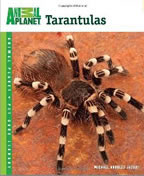Tarantula First Aid
© 2008-2013, Michael Jacobi and TARANTULAS.com
Introduction
Tarantulas are prone to very few illnesses. Some wild-caught tarantulas may have internal parasites such as nematode worms, but this is rare in captive specimens especially those that are captive-bred. The biggest concerns with captive tarantulas are dehydration and injury due to a fall or handling. Tarantulas can also lose limbs due to injury or a bad molt.
Dehydration
Even desert tarantulas live in burrows or other spaces that have a higher humidity than the outside air. Tarantulas obtain most of their moisture from their food, but it is important to provide fresh water in case they should need to drink. Please see our Basic Tarantula Care page for information on providing water and humidity. Humidity and moisture are especially important to tropical species.
I've often said that tarantulas may never drink from their water dish, but the one time they need to they will really, really need to. That is why I recommend always having a dish present. Even if it isn't used for drinking, the water evaporates over time and provides beneficial humidity. But if a spider becomes dehydrated, most often because the cage has become too dry or it hasn't fed in awhile, it may need to drink and the need may be immediate. A mildly dehydrated tarantula may have a shruken abdomen and become inactive. A more severely dehydrated tarantula will have its legs curled underneath it to some degree. Once a tarantula becomes dehydrated it requires the most basic form of tarantula first aid—the ICU cup.
"ICU", of course, is a medical acronym for "intensive care unit". In tarantula keeping, this ICU unit usually takes the form of a deli cup or margarine container that has little or no ventilation. A few small holes poked in the lid with a pin is sufficient. Paper towel liberally moistened with warm water should be folded and placed on the inside of the cup to completely cover the bottom. Make sure the towel is completely saturated so that the tarantula can drink from it, but ensure that and there is no standing water that could drown the spider. Your tarantula needs to have a water source around its mouth, which is not used for breathing, but still be able to breathe through the book lungs that are on the bottom of its abdomen. Gently place the tarantula inside and secure the lid. Place the container in a warm area. If possible, somewhere a bit above room temperature (upper 70s to mid-80s) is helpful. A mildly dehydrated tarantula will often recover within 24 hours, but a couple of days might be necessary. Having a second clean container ready to move the tarantula into if the towel becomes dry or dirty is a good idea. Check on the spider a couple of times a day and move to clean container as needed.
If a tarantula is more severely dehydrated it may become necessary to immediately place its mouth in water. Again, the bottom surface of the abdomen (or opisthosoma) where the book lung openings are situated must be kept out of standing water so the tarantula can breathe. Angling the tarantula into a shallow water container like a petri dish, with only the mouth in the water is best.
Super Glue and Injury Repair
Household super glue is the most essential item in the tarantula keeper's first aid kit. If your tarantula is injured due to a fall or other mishap, having super glue to mend the wound and clot the flow of hemolymph is imperative. Hemolymph is the tarantula's "blood" and it is a clearish-whitish-pale bluish liquid (depending on who is describing it). Careful application of super glue can even repair ruptures to the abdomen if the injury is caught immediately.
Leg Regeneration
If your tarantula loses a leg or pedipalp and it heals cleanly it will be replaced during the next molting process. In larger spiders the first molt will produce a replacement leg that is noticeably a bit smaller and not as "hairy", but after a successive molt it will look like the original. This is a natural process in invertebrate molting.
Bad Molts
Unfortunately, some tarantulas, especially those that are old or malnourished, may have difficulty molting. It is even possible for a tarantula to not completely extricate itself from its old exoskeleton before the new one begins to harden, trapping the poor spider inside. More often, a tarantula may just have difficulty with one of its legs and this might necessitate using tweezers to cleanly separate both the new and old leg. Some post-molt tarantulas may have a deformed leg. This is especially common in young tarantulas. Once the tarantula has hardened from molting (after at least four days), tweezers can be used to pluck the deformed leg cleanly off so that it can regenerate with the next molt. If the deformed leg is left to the next molt the tarantula may again have difficulty. The best way to prevent bad molts is to ensure that your tarantula is well-fed and has access to water. This should maintain its body in a fully hydrated state and reduce the possibility of molting difficulties.

